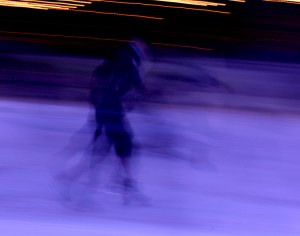 Countless text books and armchair scientists will tell you that the reason we can skate on ice is that the pressure we apply through the blades of our skates is enough to lower the freezing point of the ice so that it melts and a surface layer of slippery liquid water forms across which the skate can then glide. As with the myth about adding salt to the pan to reduce cooking time when boiling your vegetables, this is patently untrue when you do the calculations.
Countless text books and armchair scientists will tell you that the reason we can skate on ice is that the pressure we apply through the blades of our skates is enough to lower the freezing point of the ice so that it melts and a surface layer of slippery liquid water forms across which the skate can then glide. As with the myth about adding salt to the pan to reduce cooking time when boiling your vegetables, this is patently untrue when you do the calculations.
Certainly, water is an anomalous material, it expands on freezing, which is why ice floats in your G&T and why fish can still swim in lakes and rivers even if they look frozen (it’s usually just a surface layer of ice). Technically one might say that ice is the low-pressure polymorph of solid water with a volume per mole that is about 10% greater than that of liquid water. This 10% difference means that ice and icebergs float, but with 90% of their volume below the surface and only 10% sticking out. Le Châtelier’s Principle thus tells us that the melting temperature (the freezing point) of ice decreases when the pressure applied to the  ice increases. So, ice melts when you apply pressure, but the effect is very small. You need to apply a pressure 121 times that of the atmosphere (1.22 MPa, to be specific) to lower the melting temperature by just one degree Celsius.
Now how does this apply to ice skaters? In his explanatory text, chemist Kevin Lehmann of the University of Virginia tells us to assume in ice skater weighing 75 kg and the skate’s width to be 3 mm and its length 200 mm. “One can calculate that the entire gravitational force exerted on the area of one skate is only a pressure of about 12 atmospheres,” he says. This pressure is an order of magnitude too low to melt ice. Even if we had sharper blades, the maximum effect might be to lower the melting temperature of ice by at most a few tenths of a degree. The ice at an ice rink or hockey stadium is usually well below freezing, so this obviously doesn’t mesh. Skaters can skate even when the ice is very, very cold, so cold that those everyday pressures simply cannot melt the surface to make it slippery. How come?
Unfortunately, it’s one of those as yet unanswered questions as to what makes ice slippery. Scientists have theories concerning the loss of stability of solids at surfaces because there are no molecules “above” for the molecules below to bind to and there are disorder effects that are thought to give rise to surface melting, Lehmann explains. The presence of the skate somehow promotes this effect by bonding to water ice molecules, but it has little to do with the applied pressure. Perhaps the simplest explanation is that the heat generated by friction simply melts the ice. So, how much heat does a skater’s skates produce? Want to do the calculations?